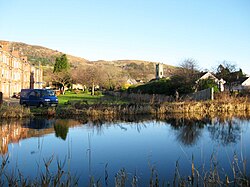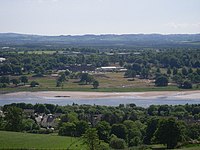Old Kilpatrick: Difference between revisions
Created page with "{{Infobox town |name=Old Kilpatrick |county=Dunbartonshire |picture=Old Kilpatrick 1109.jpg |picture caption=Old Kilpatrick and the Kilpatrick Hills |os grid ref=NS463729 |lat..." |
m →Names: Corrected author'middle initial. |
||
| (3 intermediate revisions by 2 users not shown) | |||
| Line 21: | Line 21: | ||
The village was known in Scots as 'Auld Kilpaitrick', but name is from the Gaelic language, in which it is ''Cille Phàdraig'' meaning "Patrick's church". | The village was known in Scots as 'Auld Kilpaitrick', but name is from the Gaelic language, in which it is ''Cille Phàdraig'' meaning "Patrick's church". | ||
It is widely stated that the Romans knew the place as ''Clotagenium'', supposedly but inaccurately meaning 'Clyde-mouth', but there are no local inscriptions and no historical records (e.g., in the Ravenna Cosmography) of the name. It appears to be a modern invention, from the novel ‘In the Shadow Of Rome’ by Joanna B. McGarry. | |||
==Roman fort== | ==Roman fort== | ||
Latest revision as of 17:43, 20 May 2023
| Old Kilpatrick | |
| Dunbartonshire | |
|---|---|
 Old Kilpatrick and the Kilpatrick Hills | |
| Location | |
| Grid reference: | NS463729 |
| Location: | 55°55’30"N, 4°27’33"W |
| Data | |
| Post town: | Glasgow |
| Postcode: | G60 |
| Local Government | |
| Council: | West Dunbartonshire |
| Parliamentary constituency: |
West Dunbartonshire |
Old Kilpatrick is a village in Dunbartonshire, on the north bank of the River Clyde. It marks the western end of the Antonine Wall, a Roman frontier wall which stretched from here on the Clyde to the Kinneil on the Forth.
The village stands immediately to the north of the Forth and Clyde Canal, three miles from Clydebank on the road to Dumbarton. The Great Western Road runs through Old Kilpatrick, and the next village to its west is Bowling. The modern A82 trunk road runs to the north of Old Kilpatrick, between the village and the foot of the Kilpatrick Hills. There is a legend that it was the birthplace of Saint Patrick.
Names
The village was known in Scots as 'Auld Kilpaitrick', but name is from the Gaelic language, in which it is Cille Phàdraig meaning "Patrick's church".
It is widely stated that the Romans knew the place as Clotagenium, supposedly but inaccurately meaning 'Clyde-mouth', but there are no local inscriptions and no historical records (e.g., in the Ravenna Cosmography) of the name. It appears to be a modern invention, from the novel ‘In the Shadow Of Rome’ by Joanna B. McGarry.
Roman fort
The western end of the Antonine Wall was at Old Kilpatrick (the eastern end, 37 miles distant was at Kinneil on the Forth). The physical traces of the wall had been erased but the route was surveyed during the 18th century and traced to the Chapel Hill where various Roman artefacts were found.[1]
When the Forth and Clyde Canal was being dug in 1790 the remains of a Roman bathhouse were discovered. In 1913 the foundations of the fort which had been conjectured as being in the vicinity were confirmed; in the Ravenna Cosmography, an ancient description, this site was called Clotagenium.[2]
In 1923 during redevelopment of the area significant archaeology was undertaken, which established the size and nature of the fort. Established around 81 AD, it occupied an area of about four acres enclosed by an outer defensive wall. Internally, buildings discovered included a praetorium (headquarters), barracks and a granary.[3] Major development precluded further significant excavation, and nothing is visible of the remains today: the remains lie beneath the houses of Gavinburn Gardens to the east, a large commercial building to the west and the A814 road to the north.
Later history

In about 1227, the church and lands of Kilpatrick were given to Paisley Abbey by Maldowen, Earl of Lennox. The parish remained under the supervision of the Abbey until the Reformation in 1560.[4]
At the Dissolution, the Church property fell into the possession of Lord Sempill. Eventually the lands were conferred on Claude Hamilton (a boy of ten), founder of the Abercorn family.[5] His son James Hamilton was created Lord Abercorn on 5 April 1603, then on 10 July 1606 he was made Earl of Abercorn and Lord of Paisley, Hamilton, Mountcastell and Kilpatrick.
Kilpatrick was split into two parishes - Old (Wester or West) and New Kilpatrick (also known as Easter or East) by an Act of Parliament on 16 February 1649.[6][7] This division is unusual because this was a split of both the ecclesiastical and civil parishes and the wealth and stipend of the original parish was shared between the two new parishes. It was more common for new parishes to have "daughter" status, with wealth retained by the central, or cathedral church.[4]
Old Kilpatrick was created a Burgh of barony in 1697.[8] Its population tripled between 1755 and 1821 as the spinning and weaving industries developed. By 1831 the population was 5,800.[8]
Today, the north end of the Erskine Bridge, which replaced the Erskine Ferry, lands just above the village, and the village is served by Kilpatrick railway station on the North Clyde Line.
There are three public houses within Old Kilpatrick; The Telstar, The Ettrick [9] and the Glen Lusset. The Telstar re-opened in 2011.[10]
There are two annual fêtes which are well attended. Also at the north end of Old Kilpatrick is the local school. Gavinburn Primary School (which was bombed in WW2) where they also have many fêtes annually.
The minerals edingtonite and thomsonite were first found at Old Kilpatrick.[11]
In the early 1990s a large housing estate was constructed at the edge of Old Kilpatrick, the one estate was said to double the size of Old Kilpatrick.
The local parish is St. Patrick's RC Church; the current parish priest is Fr. Francis Wilson.[12]
See also
Outside links
| ("Wikimedia Commons" has material about Old Kilpatrick) |
- Clydebank Through A Lens — a documentary about Clydebank, Scotland from the 1960s to '80s
- Post-Blitz Clydebank — a documentary about Clydebank, Scotland from 1947 to 1952
References
- ↑ Statistical Accounts of Scotland 1834-45 vol 8 p21
- ↑ http://www.romanmap.com/htm/nomina/AntonineWall.htm
- ↑ Miller, S.N. (1924) The Roman Fort at Old Kilpatrick, Glasgow Archaeological Society.
- ↑ 4.0 4.1 McCardel, J (1949). The Parish of New Kilpatrick. University Press Glasgow.
- ↑ Leicester Addis, ME (1901). The Cathedrals and Abbeys of Presbyterian Scotland. The Westminster Press.
- ↑ The Records of the Parliaments of Scotland to 1707, K.M. Brown et al (St Andrews University) Date accessed: 13 September 2011
- ↑ History of Drumchapel
- ↑ 8.0 8.1 Statistical Accounts of Scotland 1834-45 vol 8 p23
- ↑ http://www.theettrick.com/
- ↑ http://www.glenlusset.com/about
- ↑ Alec Livingstone, 2002, Minerals of Scotland, Edinburgh, National Museums of Scotland
- ↑ http://www.rcag.org.uk/parishes_stpatricks_oldkilpatrick.htm
